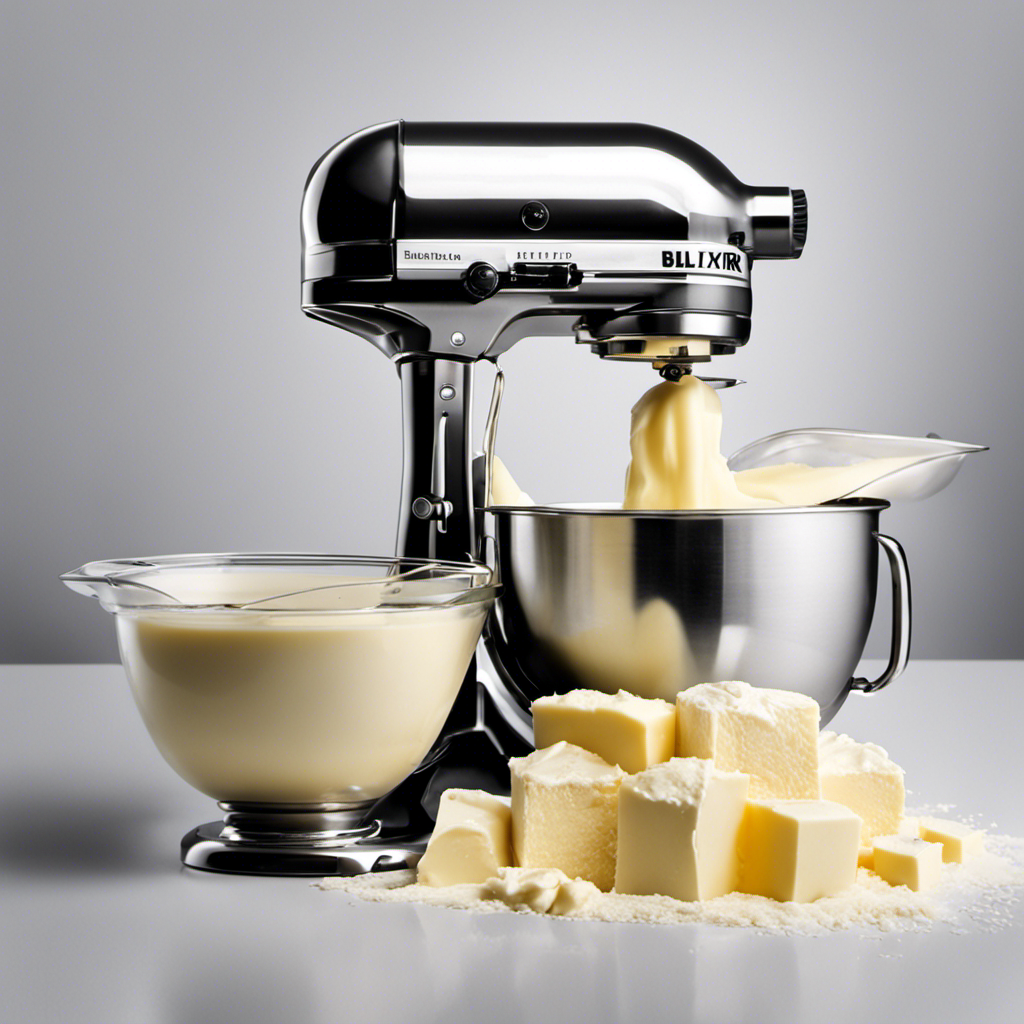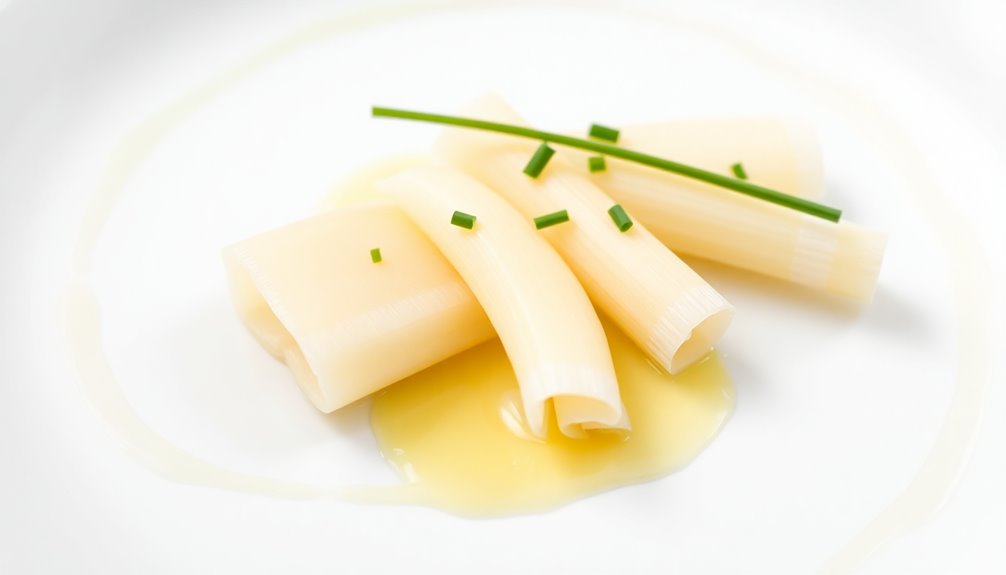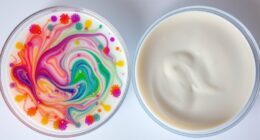To safely infuse butter with fresh herbs and prevent botulism, you should start with high-quality, clean herbs free from blemishes and mold. Use sanitized equipment and keep everything dry before starting. Slow simmer or cold infusion can help manage temperatures, but storage is key—refrigerate in airtight containers and consume within a week or freeze for longer shelf life. Watch for spoilage signs, and proper handling reduces health risks—continue to learn tips for making safe, flavorful herb butter.
Key Takeaways
- Select fresh, firm herbs free from blemishes and mold, and thoroughly sanitize all utensils and containers before use.
- Use gentle heat or cold infusion methods, ensuring butter and herbs are kept at safe temperatures to prevent bacterial growth.
- Store infused butter in airtight, refrigerated containers, and consume within one to two weeks to minimize botulism risk.
- Label containers with infusion date and herb type, and discard if signs of spoilage like mold, off odors, or discoloration appear.
- Freeze butter promptly in airtight containers for longer shelf life, reducing bacteria and toxin development risks.
Selecting Fresh Herbs for Safe Infusions

When selecting fresh herbs for infusing butter, it’s important to choose herbs that are vibrant and free from blemishes or signs of decay. Your herb selection starts with a freshness assessment—look for herbs with bright, firm leaves and no browning or wilting. Avoid herbs that look wilted, discolored, or have spots, as these may indicate age or spoilage. Fresh herbs not only provide better flavor but also reduce the risk of contamination. Check the stems for firmness and avoid any that are slimy or have mold. Smell the herbs to ensure they have a strong, fresh aroma, which signals maximum potency. Additionally, choosing herbs that are sustainably sourced can help ensure you are reducing environmental impact and supporting ethical practices. By carefully selecting herbs based on freshness, you ensure a safer, more flavorful infusion with less risk of bacterial growth.
Proper Preparation and Sanitization of Equipment
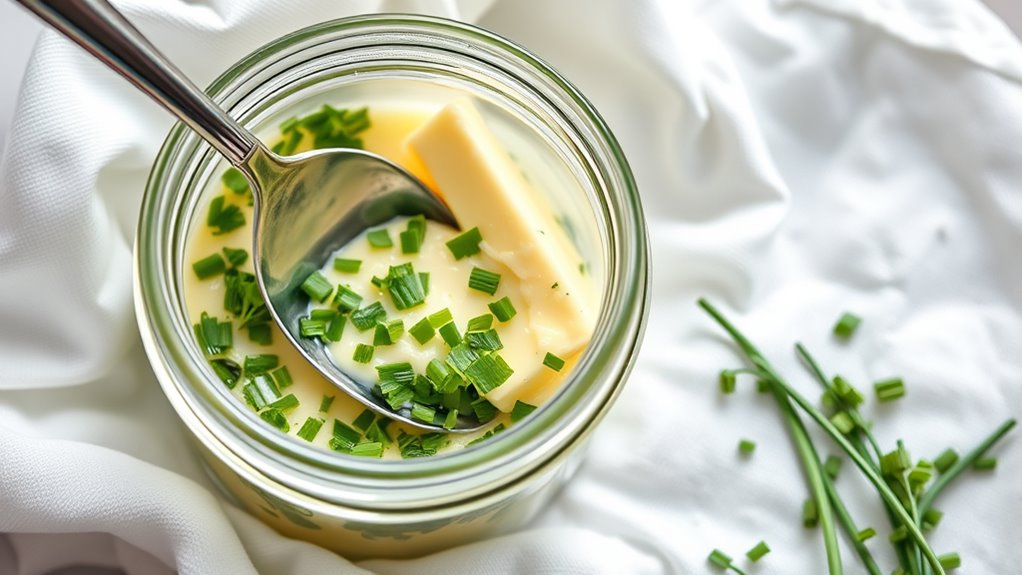
Before you start infusing butter with herbs, it’s vital to properly prepare and sanitize all your equipment. Equipment sterilization is essential to prevent contamination that could lead to dangerous bacteria growth, including botulism. Wash utensils, jars, and tools thoroughly with hot, soapy water. Rinse well, then sanitize by boiling them in water for at least 10 minutes or using a commercial sterilizer. Make certain all surfaces and containers are completely dry before use. Avoid cross-contamination by keeping raw ingredients separate and working on clean surfaces. Properly sterilized equipment reduces the risk of introducing spores or bacteria into your infusion, guaranteeing your butter remains safe for consumption. Prioritizing contamination prevention safeguards your health and preserves the quality of your infused butter. Additionally, understanding the importance of mental wellbeing can help maintain the focus and discipline needed for safe food preparation practices.
Techniques for Infusing Butter at Home
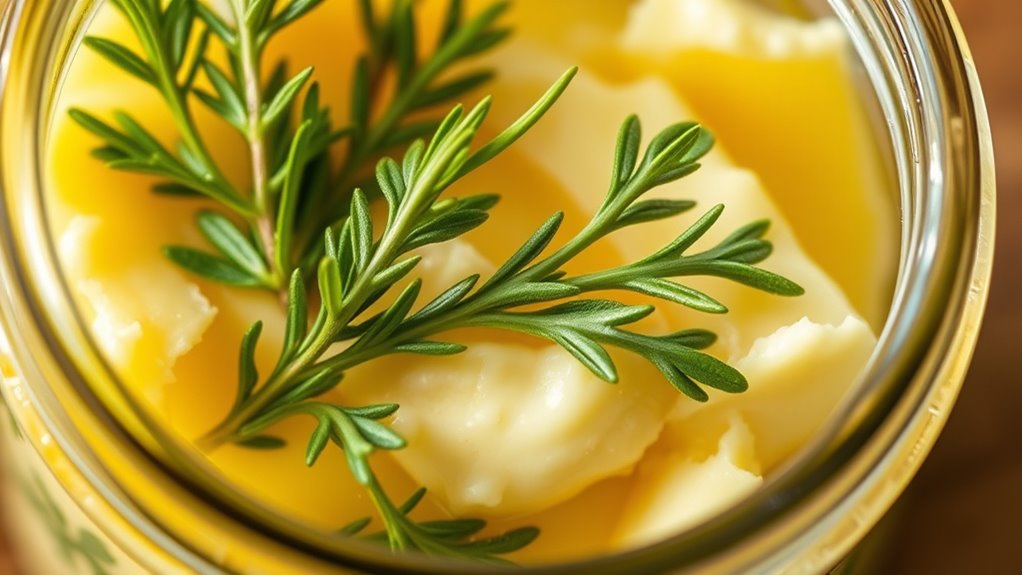
To infuse butter with fresh herbs effectively, you can choose between several straightforward techniques, each offering different flavors and intensities. The method depends on your desired herb flavor profiles and butter melting points.
One popular approach is slow simmering, which gently warms the butter to release flavors without risking overheating. Alternatively, you can melt the butter and add herbs directly, then let it sit off heat to develop flavor. For a stronger infusion, use a double boiler to control temperature precisely, preventing herb degradation. Using proper temperature control contrast ratios ensures the herbs retain their delicate flavors and aromas during infusion.
| Technique | Best For |
|---|---|
| Slow simmering | Mild, delicate flavors |
| Direct infusion | Quick, strong flavor |
| Double boiler | Precise temperature control |
| Cold infusion | Fresh, subtle herb notes |
| Oven infusion | Deep, robust flavors |
Understanding the Risks of Botulism in Dairy Products

You need to be aware of the risks of Clostridium botulinum when working with dairy products, especially homemade infused butters. Proper storage is essential to prevent bacteria growth, so keep your butter refrigerated and use it within a safe timeframe. Always watch for signs of contamination, like an off smell or unusual appearance, to guarantee your food stays safe. Incorporating creative culinary techniques can also help minimize risks while enhancing flavor.
Risks of Clostridium Botulinum
Clostridium botulinum poses a significant risk in dairy products because its spores can survive and grow in low-acid, anaerobic environments, such as certain cheeses and butter. If you don’t choose herbs carefully, you create an environment where spores might flourish. Proper herb selection is essential; avoid herbs that are contaminated or prone to harboring bacteria. Additionally, milk pasteurization plays a critical role in reducing the risk by killing most bacteria and spores present in raw milk. However, once herbs are added to butter, the environment can become anaerobic, allowing spores to produce dangerous toxins if conditions are right. To minimize risks, ensure herbs are clean and pasteurized, and be cautious about the fermentation environment to prevent botulism from developing.
Proper Storage Practices
Proper storage of herb-infused butter is vital to prevent the growth of harmful bacteria, including the spores of Clostridium botulinum. After dairy processing, store the butter in airtight containers to limit exposure to air and contaminants. Keep it refrigerated at or below 40°F (4°C), as higher temperatures promote bacterial growth. When herb flavoring is added, guarantee the herbs are fresh and properly washed to reduce bacteria. Avoid leaving infused butter at room temperature for extended periods, as this creates a prime environment for botulism spores to activate. Always label your storage containers with the date of preparation and consume the butter within a week or two. Additionally, understanding the types of bacteria that can develop in dairy products helps in implementing effective storage practices. Proper storage practices are essential to maintaining safety and preventing foodborne illnesses in dairy products.
Signs of Contamination
Recognizing signs of contamination in herb-infused butter is essential for preventing foodborne illnesses like botulism. Start by checking the herb freshness; wilted or discolored herbs can indicate spoilage. Look for any unusual odors—sour, rancid, or off-putting smells are clear contamination indicators. If you notice mold or a slimy texture on the butter or herbs, discard immediately. Changes in color, such as dark spots or a dull appearance, also signal potential issues. Always trust your senses—visual cues, smells, and textures—and avoid consuming anything that seems suspect. Properly stored herb-infused butter should remain fresh and free of visible or olfactory contamination indicators. Staying vigilant helps ensure your butter remains safe and free from harmful bacteria like those that cause botulism. Additionally, understanding AI-driven insights into food safety can help you better identify contamination risks through advanced monitoring techniques.
Optimal Storage Methods for Herb-Infused Butter

To keep herb-infused butter fresh and flavorful, storing it correctly is essential. You want to preserve the delicate herb flavor combinations without risking spoilage. Use airtight storage container options like glass jars or silicone molds to prevent air exposure, which can cause spoilage and flavor loss. Keep the infused butter refrigerated at or below 40°F (4°C), and avoid leaving it at room temperature for extended periods. Label your containers with the date to track freshness. For added safety, ensure your utensils are clean before handling the butter. Proper storage minimizes contamination risks and maintains the herb-infused butter’s quality, allowing you to enjoy fresh herb flavors in your dishes longer. Additionally, understanding the importance of fatherhood and the role of a caring parent can remind us of the value of nurturing and protecting our culinary creations.
Preserving Infused Butter Through Freezing

To keep your herb-infused butter fresh, freeze it soon after infusion. Use airtight containers to prevent freezer burn and label each with the date to track freshness. Properly stored, your butter will stay flavorful for months. Understanding food safety is essential to prevent risks like botulism when preserving homemade products.
Freeze Soon After Infusing
Once you’ve infused your butter with fresh herbs, it’s important to freeze it promptly to preserve its flavor and quality. Freezing slows down the degradation of herb flavoring and prevents the growth of bacteria that could compromise safety. During butter extraction, some delicate herb oils can evaporate or weaken if left out too long, so quick freezing locks in those essential flavors. Place your infused butter into airtight, freezer-safe containers or wraps as soon as it cools. Label the packages with the date to track freshness. Freezing not only maintains the vibrant herb flavoring but also minimizes the risk of botulism, ensuring your infused butter remains safe and delicious for future use. Prompt freezing is a key step in safe herb-infused butter preparation. Proper storage methods help maintain freshness and safety over time.
Use Airtight Containers
Using airtight containers is essential for preserving your infused butter during freezing. They prevent air exposure, which can cause freezer burn and spoilage, ensuring your butter stays fresh and safe. Choose containers with secure seals to maintain an airtight environment. When selecting herbs for infusion, opt for high-quality, fresh herb selection to maximize flavor and safety. Properly stored in airtight containers, your infused butter remains protected from moisture and contaminants. This method also helps prevent odor transfer within the freezer, keeping your butter tasting as intended. Before sealing, ensure any excess air is removed, and the container lid clicks firmly into place. Using the right airtight containers not only extends shelf life but also preserves the herb-infused butter’s potency and safety during freezing.
Label With Date
Ever wonder how to keep track of when you made your infused butter? Label with the date on your airtight container or jar. This simple step helps you monitor freshness and guarantees safety, especially when storing in the freezer. Different herb varieties impart unique flavor profiles, from the sharpness of basil to the earthiness of thyme. Knowing when you made the infusion helps you enjoy these herbal flavors at their peak and prevents accidentally using spoiled butter. Write the date clearly with a permanent marker, and include the herb variety for quick identification. Proper labeling makes it easier to rotate your infused butter, keeping your kitchen organized and your culinary creations safe and flavorful. Remember, freezing extends shelf life, but proper labeling ensures you use your herbs at their best.
Recognizing Signs of Spoilage and Contamination

You should regularly check your herb-infused butter for signs of spoilage to guarantee it’s safe to use. Pay close attention to herb freshness and look for contamination indicators that signal it’s time to discard. Changes in color or texture, such as a greasy or slimy film, are warning signs. A sour or off smell often indicates bacterial growth. Visible mold or dark spots are clear contamination indicators. Additionally, if bubbles or unusual foaming appear, it could mean fermentation or spoilage. Always trust your senses—if anything seems off, it’s best to err on the side of caution and discard the butter. Regular inspection helps prevent foodborne illness and ensures your herb-infused butter stays safe and delicious. Food spoilage signs are crucial to recognize to maintain food safety standards.
Tips for Safe Consumption and Usage
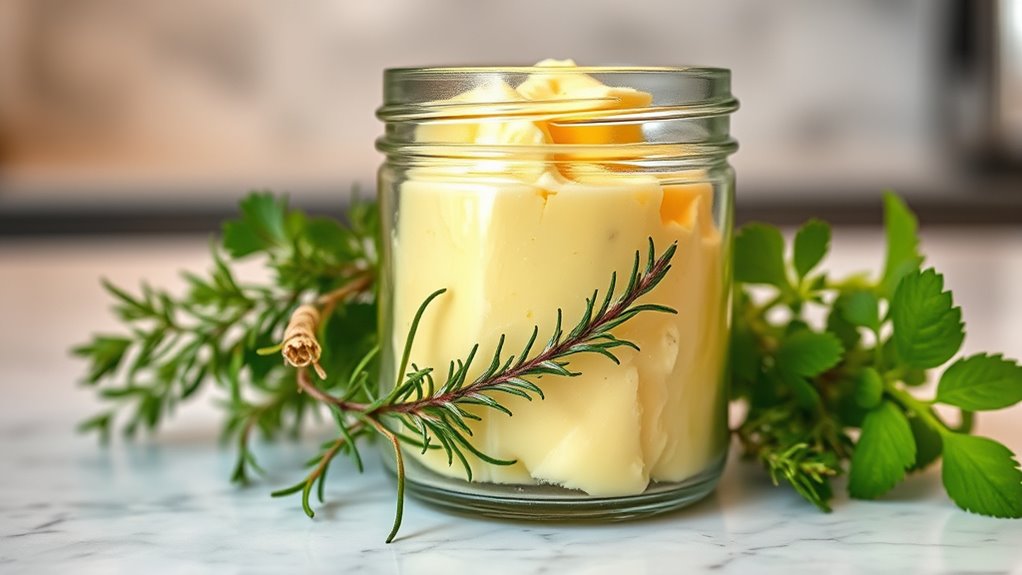
To enjoy herb-infused butter safely, always store it in an airtight container in the refrigerator and consume it within a week or as recommended. Choose herb varieties like parsley, chives, or basil that complement your dishes and enhance flavor pairing. Be mindful of the herbs’ freshness and quality, as this affects safety and taste. Before using, check for any signs of spoilage, such as off odors or discoloration. When incorporating infused butter into recipes, start with small amounts to gauge flavor and avoid overuse. Keep it chilled when not in use, and never leave it at room temperature for extended periods. Proper storage and mindful usage ensure you enjoy the rich flavors of your herb-infused butter without risking health issues.
Frequently Asked Questions
How Long Can Herb-Infused Butter Be Stored Safely?
Herb-infused butter can typically be stored safely for about 1 to 2 weeks in the refrigerator. During this storage duration, you should check for spoilage signs like mold, off smells, or discoloration. To maximize freshness and safety, keep it in an airtight container and always use clean utensils when handling it. If you notice any spoilage signs, discard the butter immediately to prevent health risks.
Can Dried Herbs Be Used Instead of Fresh for Infusions?
Did you know dried herbs can be used for infusions? While fresh herbs are popular, dried herbs can work, but they often have a different infusion potency. Dried herbs tend to release flavors more slowly and may need longer infusion times. If you choose dried herbs, make sure they’re thoroughly dried and stored properly to prevent spoilage. Using dried herbs can be a convenient option, but adjust your recipe for maximum flavor extraction.
Is It Safe to Reuse Herb-Infused Butter in Recipes?
You can reuse herb-infused butter in recipes, but pay attention to herb potency and storage guidelines. If the butter has been stored properly in the fridge and shows no signs of spoilage, it’s generally safe to reuse. However, over time, the herb flavor may diminish, and bacteria could develop if not stored correctly. Always check for off odors or mold before using leftover infused butter to ensure safety.
What Are Alternative Methods to Infuse Butter Without Heating?
Did you know that cold infusion is a popular method that preserves fresh herb flavors without heat? You can achieve herb extraction by steeping herbs in room temperature butter for several hours or overnight, avoiding the risks associated with heating. This method keeps the butter safe, flavorful, and preserves delicate herb aromas. Cold infusion is an excellent alternative, especially if you’re concerned about overcooking or losing fresh herb nuances.
How Can I Tell if My Herb-Infused Butter Has Developed Botulism?
You should watch for signs to watch for, like a foul odor, unusual discoloration, or mold detection on your herb-infused butter. If you notice any changes in texture, color, or smell, discard it immediately. Avoid tasting if you suspect spoilage. Remember, botulism bacteria are invisible and don’t change the appearance, so when in doubt, it’s safest to throw it out to prevent health risks.
Conclusion
By following these safe infusion tips, you’ll turn ordinary butter into a flavorful herb masterpiece without risking your health. Remember, neglecting proper procedures can lead to botulism—an invisible threat more dangerous than you can imagine. Always prioritize cleanliness, use fresh herbs, and store your infused butter correctly. With careful attention, you’ll enjoy your delicious, herb-infused butter safely, transforming your culinary creations into a taste explosion that’s unforgettable and completely risk-free.


